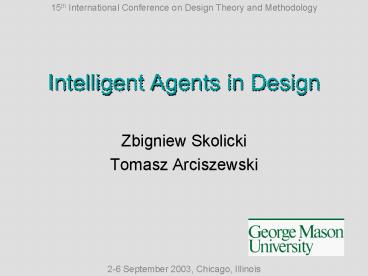Intelligent Agents in Design PowerPoint PPT Presentation
Title: Intelligent Agents in Design
1
Intelligent Agents in Design
- Zbigniew Skolicki
- Tomasz Arciszewski
2
Outline
- Agents and learning
- Attributes
- Statistical analysis
- Directed Evolution perspective
- Conclusions
3
Agents and learning
4
Agent versus Intelligent Agent
- Agent
- Autonomous
- Active
- Takes initiative
- Repeatedly interacts with the environment(and
the user of other agents) - Mobile?
- Intelligent Agent
- Adaptive
- Learning
5
Our definition of Intelligent Agent (IA)
- An intelligent agent is an autonomous system
situated within an environment, it senses its
environment, maintains some knowledge and learns
upon obtaining new data and, finally, it acts in
pursuit of its own agenda to achieve its goals,
possibly influencing the environment
6
Attributes
7
Attributes
- 27 binary attributesFor exampleInformation
whether agents store information locally or in
some shared memoryStability whether agents can
reconfigure in the runtimeSwarm? whether there
is enough number of agents interacting to create
macroscopic effects - Values for attributes
- 0 simple behavior
- 1 complex behavior
8
5 classes of attributes
- Sensing ActingWhat the pattern of interaction
is, is it dynamic, what causes action, what
resources are available? - ReasoningWhat is communicated, how deep and fast
and prompt the reasoning is? - Learning KnowledgeHow adaptable the agent is,
where is the knowledge stored, is it consistent,
what can an agent learn? - StructureHow is an agent built, is it reusable,
can it reconfigure, can new agents be added? - QuantityHow many agents interact and can it lead
to an emergent behavior?
9
Agents in Design
10
Agents in Design
- Reemergence of interest
- First International Workshop on Agents in Design,
MIT 2002
11
Conducted analysis
- 17 agents or agent systems
- 27 binary attributes
- 17 x 27 459 values assessed
- Statistical analysis of the values
- Mean attribute value
- Each attribute analyzed separately
- Swarm systems analyzed separately
12
Results
Complexagents
Simple agents
Expected mean attributes value
Gaussian distribution ? attributes chosen
independently?
13
Identified Agents Features(each attribute
analyzed independently)
- Act locally
- Cooperate
- Are sophisticated
- Are not real-time
- Do not model other agents
- Do not show internal state
- Are trustful
- Acquire knowledge
- Have stable architecture
- Work in groups
14
Swarm agents unique features
- Act more locally
- Share resources
- Have less autonomy
- Are more competitive
- Are more mobile
- May discover roles in runtime
- React more directly
- Are not real-time
- Are less transparent
- Use fixed language
- Assume information to be true
- Are less reusable
- 90 confidence
15
Directed Evolution
16
Directed evolution
- Evolution of engineering systems occurs according
to Patterns of Evolution - Directed Evolution enables planning and
development of future generations of engineering
systems. - Theory of Inventive Problem Solving (TRIZ)
- Line of evolution
17
Current stage of IAs(according to Patterns of
Evolution)
- Run-time acquisition of knowledge
- Growing number of features
- Growing flexibility and controlability
- Starting simplification
- Component architecture ?
- Common-day use
- Automation and decreased human involvement
18
Conclusions
- Learning and adaptability important
- Agents in Design still in early evolution stages
- Directed Evolution approach premature
- Research niches simple, reconfigurable,
reusable, competing, real-time, modeling others,
non-naïve agents
19
Thank you for your attention!
- Questions?

